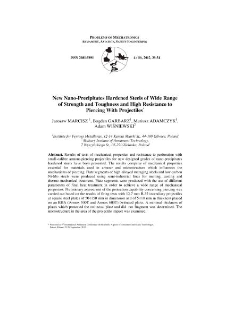Nasza Biblioteka Cyfrowa udostępnia 1 868 obiektów cyfrowych
Obiekt
Tytuł: New Nano-Precipitates Hardened Steels of Wide Rangeof Strength and Toughness and High Resistance to Piercing With Projectiles ; New Nano-Precipitates Hardened Steels of Wide Rangeof Strength and Toughness and High Resistance to Piercing With Projectiles
Współtwórca:
Bogdan GARBARZ, Mariusz ADAMCZYK, Adam WIŚNIEWSKI ; Bogdan GARBARZ, Mariusz ADAMCZYK, Adam WIŚNIEWSKI
Abstrakt:
Results of tests of mechanical properties and resistance to perforation with small-calibre armour-piercing projectiles for new designed grades of nano-precipitates hardened steels have been presented. The results comprise of mechanical properties essential for materials used in armour and microstructure which influences the mechanisms of piercing. Plate segments of high-alloyed maraging steels and low-carbon Ni-Mo steels were produced using semi-industrial lines for melting, casting and thermo-mechanical treatment. Plate segments were produced with the use of different parameters of final heat treatment in order to achieve a wide range of mechanical properties. Preliminary assessment of the protection capability concerning piercing was carried out based on the results of firing tests with 12.7 mm B-32 incendiary projectiles at square steel plates of 50÷150 mm in dimension and of 5÷10 mm in thickness placed on an RHA (Armox 500T and Armox 600T) “witness” plate. A minimal thickness of plates which protected the “witness” plate and did not fragment was determined. The microstructure in the area of the projectile impact was examined.
The usability of newly designed grades of steel in layered armour and the possibilities of the production of these plates from the steel in domestic steel plants were pointed out.
;
Results of tests of mechanical properties and resistance to perforation with small-calibre armour-piercing projectiles for new designed grades of nano-precipitates hardened steels have been presented. The results comprise of mechanical properties essential for materials used in armour and microstructure which influences the mechanisms of piercing. Plate segments of high-alloyed maraging steels and low-carbon Ni-Mo steels were produced using semi-industrial lines for melting, casting and thermo-mechanical treatment. Plate segments were produced with the use of different parameters of final heat treatment in order to achieve a wide range of mechanical properties. Preliminary assessment of the protection capability concerning piercing was carried out based on the results of firing tests with 12.7 mm B-32 incendiary projectiles at square steel plates of 50÷150 mm in dimension and of 5÷10 mm in thickness placed on an RHA (Armox 500T and Armox 600T) “witness” plate. A minimal thickness of plates which protected the “witness” plate and did not fragment was determined. The microstructure in the area of the projectile impact was examined.
The usability of newly designed grades of steel in layered armour and the possibilities of the production of these plates from the steel in domestic steel plants were pointed out.
Miejsce wydania:
Warszawa
;
Warszawa
Wydawca:
Wojskowa Akademia Techniczna ; Wojskowa Akademia Techniczna
Data utworzenia:
Data wydania:
Rozmiar:
Identyfikator:
oai:ribes-88.man.poznan.pl:2374
ISSN elektroniczny:
ISSN drukowany:
Język:
Właściciel praw:
Wojskowa Akademia Techniczna ; Wojskowa Akademia Techniczna
Strona początkowa:
Strona końcowa:
Tom:
Słowa kluczowe:
materials engineering, steel, armour plates, precipitation hardening,resistance to perforation ; materials engineering, steel, armour plates, precipitation hardening,resistance to perforation
Kolekcje, do których przypisany jest obiekt:
Data ostatniej modyfikacji:
14 sie 2025
Data dodania obiektu:
14 sie 2025
Liczba wyświetleń treści obiektu:
0
Wszystkie dostępne wersje tego obiektu:
https://ribes-88.man.poznan.pl/publication/2674
Wyświetl opis w formacie RDF:
Wyświetl opis w formacie OAI-PMH:
Obiekty Podobne
Igor BARÉNYI Ondrej HÍREŠ, Peter LIPTÁK
Jarosław MARCISZ Wojciech BURIAN, Jerzy STĘPIEŃ, Lech STARCZEWSKI, Małgorzata WNUK
Jarosław MARCISZ Jerzy STĘPIEŃ, Jan MATERNIAK, Zdzisław KACZMAREK, Dariusz SZAŁATA, Bogdan GARBARZ, Mariusz ADAMCZYK, Wojciech BURIAN
Jarosław MARCISZ Bogdan GARBARZ, Jacek JANISZEWSKI

